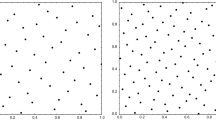Following the line of investigation in [Linear Algebra Appl., 487, 22–42 (2015)], for y ∈ ℝ and a sequence x = (xn) ∈ ℓ∞, we define a new notion of density δg with respect to a weight function g of indices of the elements xn close to y, where g : ℕ → [0, ∞)is such that g(n) → ∞and n/g(n)0. We present the relationships between the densities δg of indices of (xn) and the variation of the Cesàrolimit of (xn). Our main result states that if the set of the limit points of (xn) is countable and δg(y) exists for any y ∈ ℝ, then
which is an extended and much more general form of the “natural version of density from the Osikiewicz theorem.” Note that, in [Linear Algebra Appl., 487, 22–42 (2015)], the regularity of the matrix was used in the entire investigation, whereas in the present paper, the investigation is actually performed with respect to a special type of matrix, which is not necessarily regular.
Similar content being viewed by others
References
M. Balcerzak, K. Dems, and A. Komisarski, “Statistical convergence and ideal convergence for sequences of functions,” J. Math. Anal. Appl., 328, No. 1, 715–729 (2007).
M. Balcerzak, P. Das, M. Filipczak, and J. Swaczyna, “Generalized kinds of density and the associated ideals,” Acta Math. Hungar., 147, No. 1, 97–115 (2015).
A. Bartoszewicz, P. Das, and S. Glab, “On matrix summability of spliced sequences and A-density of points,” Linear Algebra Appl., 487, 22–42 (2015).
S. Bhunia, P. Das, and S. K. Pal, “Restricting statistical convergence,” Acta Math. Hungar., 134, 153–161 (2012).
A. Bartoszewicz, S. Głąb, and A. Wachowicz, “Remarks on ideal boundedness, convergence and variation of sequences,” J. Math. Anal. Appl., 375, No. 2, 431–435 (2011).
P. Das, “Some further results on ideal convergence in topological spaces,” Topology Appl., 159, 2621–2625 (2012).
A. Faisant, G. Grekos, and V. Toma, “On the statistical variation of sequences,” J. Math. Anal. Appl., 306, No. 2, 432–439 (2005).
H. Fast, “Sur la convergence statistique,” Colloq. Math., 2, 241–244 (1951).
R. FilipÓw, N. Mrożek, I. Recław, and P. Szuca, “Ideal convergence of bounded sequences,” J. Symb. Log., 72, No. 2, 501–512 (2007).
R. FilipÓw and P. Szuca, “On some questions of Drewnowski and Łuczak concerning submeasures on N,” J. Math. Anal. Appl., 371, No. 2, 655–660 (2010).
R. FilipÓw and P. Szuca, “Density versions of Schur’s theorem for ideals generated by submeasures,” J. Combin. Theory Ser. A., 117, No. 7, 943–956 (2010).
A. R. Freedman and J. J. Sember, “Densities and summability,” Pacific J. Math., 95, 293–305 (1981).
J. A. Fridy, “On statistical convergence,” Analysis, 5, No. 4, 301–313 (1985).
J. A. Fridy, “Statistical limit points,” Proc. Amer. Math. Soc., 118, No. 4, 1187–1192 (1993).
R. Henstock, “The efficiency of matrices for bounded sequences,” J. Lond. Math. Soc., 25, 27–33 (1950).
J. Jasiński and I. Recław, “On spaces with the ideal convergence property,” Colloq. Math., 111, No. 1, 43–50 (2008).
P. Kostyrko, T. Šalát, and W. Wilczyński, “\( \mathcal{T} \)-convergence,” Real Anal. Exchange, 26, No. 2, 669–685 (2000/2001).
B. K. Lahiri and P. Das, \( \mathcal{T} \) and \( {\mathcal{T}}^{\ast } \)⇤-convergence in topological spaces,” Math. Bohem., 130, 153–160 (2005).
N. Mrożek, “Ideal version of Egorov’s theorem for analytic P-ideals,” J. Math. Anal. Appl., 349, No. 2, 452–458 (2009).
J. A. Osikiewicz, “Summability of spliced sequences,” Rocky Mountain J. Math., 35, No. 3, 977–996 (2005).
E. Savas, P. Das, and S. Dutta, “A note on strong matrix summability via ideals,” Appl. Math. Lett., 25, No. 4, 733–738 (2012).
E. Savas, P. Das, and S. Dutta, “A note on some generalized summability methods,” Acta Math. Univ. Comenian (N.S.), 82, No. 2, 297–304 (2013).
I. J. Schoenberg, “The integrability of certain functions and related summability methods,” Amer. Math. Monthly, 66, 361–375 (1959).
S. Solecki, “Analytic ideals and their applications,” Ann. Pure Appl. Logic, 99, No. 1-3, 51–72 (1999).
Author information
Authors and Affiliations
Corresponding author
Additional information
Published in Ukrains’kyi Matematychnyi Zhurnal, Vol. 71, No. 9, pp. 1192–1207, September, 2019.
Rights and permissions
About this article
Cite this article
Bose, K., Das, P. & Sengupta, S. On Spliced Sequences and the Density of Points with Respect to a Matrix Constructed by using a Weight Function. Ukr Math J 71, 1359–1378 (2020). https://doi.org/10.1007/s11253-020-01720-1
Received:
Revised:
Published:
Issue Date:
DOI: https://doi.org/10.1007/s11253-020-01720-1




